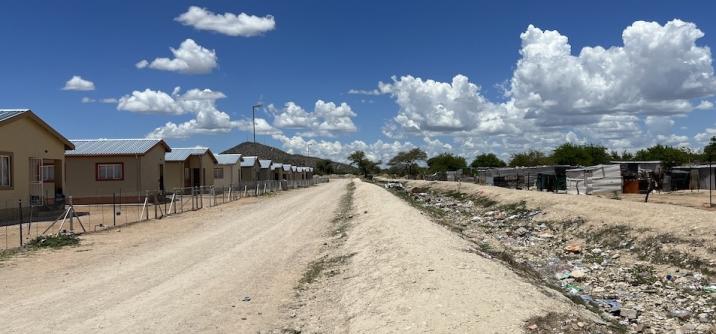The cost effectiveness of alternative options to address housing need in Karibib

The research project aims to unpack the costs of land servicing for housing in different projects in Karibib. This is to understand the efficiency of investments in housing, the usefulness of subsidies, and the most appropriate approaches to address the need of the lowest income groups.
Researchers: Guillermo Delgado, Anna Muller, Braam Harris, Tapiwa Maruza, and Diana Mitlin; with students from the Architecture, Construction, and Accounting at the Namibia University of Science and Technology.
Aims
a. Undertake a cost effectiveness study of five ongoing and varied initiatives to address housing need in Karibib (private sector supported by mining companies, National Housing Enterprise supported housing, Development Workshop supported housing through the provision of serviced sites, community supported provision of serviced sites, community supported housing construction).
b. Analyse and report on the income groups reached by these different initiatives. Summary of key socio-economic characteristics. Summary of the affordability of the five housing improvements.
c. Share findings of the affordability analysis and cost-effectiveness study with key government officials and those involved in the preparation of the UN Habitat participatory slum upgrading review.
Background
In 2013 the Namibian government launched the mass housing programme. Unfortunately, the programme failed to reach the lowest income groups in the country, particularly the estimated 40 per cent of the Namibian population (and 80 per cent of the urban population) who live in informal settlements, frequently in shacks. The government recognised this failing and suspended the mass housing programme; there is currently a policy vacuum. Solutions are contested. It is not clear where the government can best invest its scarce resources, and for those working to ensure the lowest income groups secure the basic services and secure tenure promised in the SDGs, there is a real concern that they will be left out of any government programme.
To advance thinking in this area, the government agreed that NUST would work with a group of stakeholders, the National Alliance for Informal Settlement Upgrading, and UN Habitat to prepare a participatory slum upgrading strategy. That strategy is due to be completed in September 2022. However, the budget is small and key information is lacking.
Expected outputs and outcomes
The cost effectiveness and affordability analysis will be written up in a report. This report will form part of the participatory slum upgrading strategy, and will be presented (in a colour printed report) to a small meeting of key stakeholders in Windhoek (in September 2022).The project will also inform the revision of the National Housing Policy, which is currently done by a task team in which NUST is a member.
The findings will be written up and submitted to a high-impact journal dealing with housing issues in the global South. The outcome that is sought is that the Government of Namibia better understands the effectiveness and affordability of the five housing initiatives.
Timeframe. The team will undertake fieldwork throughout February 2023, and present results within the first quarter of the year.
Outcomes. The project will produce one academic paper, one policy brief, and will convene an event to engage partners around the results of the research.
Partner institutions. The Institute for Land, Livelihoods and Housing (ILLH) is a centre at the Namibia University of Science and Technology (NUST); the Shack Dwellers Federation of Namibia and the Namibia Housing Action Group; with support of the SEED Social Responsibility Catalyst Fund, at the University of Manchester.

